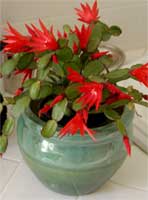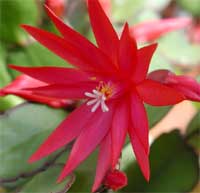Resource Library
Plant of the Week: Easter Cactus
The University of Arkansas System Division of Agriculture does not promote, support or recommend plants featured in "Plant of the Week." Please consult your local Extension office for plants suitable for your region.
Plant of the Week
Easter Cactus
Latin: Hatiora gaertneri

Usually when we think of Easter and a plant, the Easter lily comes to mind. But there is another option - the spring-blooming Easter cactus, Hatiora gaertneri.
This epiphytic cactus, like the more familiar Thanksgiving and Christmas cactus, hails from the southeastern coast of Brazil and was probably introduced to Europe from Rio de Janeiro sometime in the 18th century. Rio, which sits on the shore of Guanabara Bay, is the most important port in South America and most sailing vessels re-provisioned there as they made their way around the Horn or back to Europe.
Easter cactus is a succulent, jointed, spine-free cactus with 2- to 3-inch long segments. Segments are usually flattened, but older stems may become triangular. Between the segments and at the tips are soft, brownish bristles. The edges of the segments (called phylloclads) are often ringed with a purplish fringe.
The red flowers are 2 inches across and made up of a uniform fringe of 12 to 15 pointed petals that radiate out like a hula dancer’s skirt. The blooms close at dusk and reopen as the day brightens. Unlike Christmas cactus flowers that only last four or five days, individual Easter cactus flowers continue to open and close for 10 to 14 days with plants having an effective floral display of about 20 days.
This cactus is named for Joseph Gartner (also spelled Gaertner - 1732-1791), a German professor of botany. He traveled extensively between botanical centers in Europe but never made his way to the New World. Gaertner was the first to describe the mistletoe cactus and created the genus Rhipsalis. He is better known in botanical circles for his early work on seeds and their internal workings.
Easter cactus has never hit it big as a holiday crop because it takes too long to produce. Greenhouse growers prefer plants that finish in twelve weeks, not twelve months.

In Europe it’s a popular wintertime pot plant with florists in Denmark and Holland producing up to five million pots a year. Changes being proposed to plant quarantine rules are afoot to allow shipment of Easter cactus growing in soil to be imported directly, so we may see more of these plants in the marketplace in the future.
Another reason for increasing interest in Easter cactus is the breeding work by University of Massachusetts professor Thomas Boyle. Boyle is a plant breeder who has studied the breeding behavior of the holiday cacti for the past 15 years. From these studies he has selected 10 new hybrids, with ‘Rio’ the first to be named and patented.
Easter cactus is a short day plant that forms flower buds during the cool days of fall, but unlike Thanksgiving and Christmas cacti, these buds must have a rest period before they’ll open. Nighttime temperatures around 55 degrees Fahrenheit for 12 weeks are ideal to satisfy this wintertime rest period.
Easter cactus is easy to grow so long as it receives bright light, but not necessarily full sun, during the summer growing period. Fertilize as you would any houseplant during the summer months. It’s very susceptible to stem rot if planted in a heavy soil or overwatered, which is easy to do during the dormancy period when only occasional watering is needed.
By: Gerald Klingaman, retired
Extension Horticulturist - Ornamentals
Extension News - April 28, 2006
The University of Arkansas System Division of Agriculture does not maintain lists of retail outlets where these plants can be purchased. Please check your local nursery or other retail outlets to ask about the availability of these plants for your growing area.